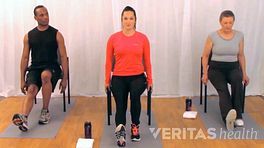The following guidelines and insights are designed to help patients plan and follow through with a safe and effective exercise program to condition the back. The key goals of engaging in exercise and fitness activities are to aid the healing process for an injured back and alleviate existing back pain while helping to prevent (or at least minimize) future problems.
- Find the right type of professional to help with the exercise and fitness program. Patients should always consult with a physician prior to beginning any exercise or fitness program. A healthcare professional can assist with the development of an appropriate list of back exercises and activities in which to engage or avoid. Health professionals such as physical therapists, chiropractors, and physical medicine and rehabilitation physicians (physiatrists) often have specific training and expertise with exercise and fitness programs for pain relief. It's particularly important to see a health professional with expertise in spinal conditions and back pain, as different back conditions often require very different exercise programs.
- Expect some initial discomfort when beginning a new exercise and fitness program. However, start slowly, because the results of back exercise, such as soreness, may not be felt for 24 to 48 hours after the exercise session. Beginning an exercise program after an episode of back pain will likely cause some increase in pain in the beginning. However, the back pain experienced during exercise should be "good pain." This pain is to be expected as a natural part of increasing activity and stretching tissues that have become stiff and deconditioned.
- Set a careful pace when starting to exercise. When returning to activity after an episode of pain or following surgery, ease into back exercise and physical activity. Be careful not to overwork or strain muscles that may have become deconditioned after a period of inactivity. Taking into account that there may be some initial discomfort, a cautious approach to back exercise can help keep back pain under control and prevent a flare-up.
- Include a combination of stretching, strengthening, and low-impact aerobic conditioning exercise. Utilizing these three components of exercise will help heal existing problems, avoid injury and prevent future problems. Muscles will become strengthened and more flexible, repairing strained muscles that cause back pain. Low-impact aerobic conditioning helps to stretch and strengthen the back as well as the abdominals and hamstrings, two muscles that help to support the back.
- Engage in gentle forms of exercise, such as water therapy or walking. For patients experiencing higher levels of back pain, exercise may be more comfortable in the water than on land. Water therapy provides the therapeutic effect of relieving pain and also can help prepare the body for more extensive exercise. Another form of gentle physical activity is exercise walking, a good option for patients in less pain who are ready to move onto more intensive exercises on land.
- Consider alternative forms of exercise, such as Pilates, yoga, or Tai Chi. Pilates, yoga, and Tai Chi provide gentle strengthening and stretching exercise that can help alleviate present back pain. They help improve overall fitness and posture, which in turn prevents future episodes of back pain. Other benefits of alternative therapies like Pilates, yoga, and Tai Chi are stress relief and relaxation, which can also assist with back pain relief.
- Know when to reassess the exercise and fitness program. If back pain during exercise becomes severe, it is important to redesign the back exercise program with the help of a professional. The individual patient is the best judge of whether the pain during exercise is normal discomfort or if the level of pain is signaling that the patient should discontinue the specific exercise.
- Build a motivating support system during the course of the exercise program. Friends and family may often encourage patients to rest and avoid physical activity because of the common misconception that exercise causes back pain. However, the opposite is true when patients perform the appropriate back exercises. The patient may need to educate others about the importance of back exercise and fitness for back pain relief. Telling friends and family about plans to increase start exercising and asking for their encouragement may help the program’s success.
- Keep a written record of progress made during the exercise and fitness program. Tracking progress is useful for the patient as well as for health professionals who are helping with the exercise program. Records could include a list of the specific back exercises performed, number of sets and repetitions, duration of exercise, and pain and sensations experienced during exercise. This helps both the patient and the exercise professional track progress toward fitness goals and ensures that information is accurately communicated among different professionals and to the patient. Monitoring progress may also help keep the patient motivated to continue with the exercise and fitness program.








